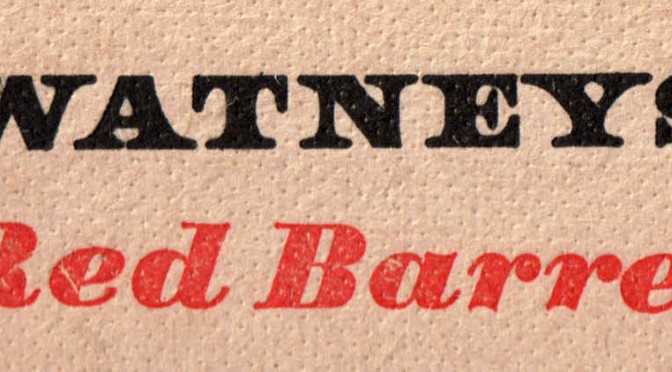For our first attempt to extract a home brewing recipe from the Kegronomicon we’ve gone for the original Red Barrel, Watney’s Keg (RBWK) as it was in around 1966.
There’s a huge amount of technical information in the documents that won’t be of much practical use to home brewers, and which we barely understand, so we’ve concentrated on the key parameters which should enable you to get vaguely close if you plug them into your own brewing software and/or process.
In general, though, the emphasis throughout is on absolute cleanliness: contact with oxygen should be minimised at every stage; and everything should be kept completely, obsessively sterile.

And if you happen to have a bloody big industrial filtering and pasteurising facility, use it — that’s probably the biggest influence on how this beer would have tasted at the time.
Our primary source for vital statistics was a memo dated 26 August 1966, from F.W. Dickens of the Red Barrel & Draught Beer Department, Mortlake, providing a single handy summary of revised targets for colour, OG, IBU and carbonation.
We also cross-referenced with OG/ABV data from Whitbread’s analysts via Ron Pattinson.
Red Barrel, Watney’s Keg, c.1966
OG 1038 | FG 1009 | c.3.8% ABV | 30-32 IBU | 27 EBC
| Pale malt | 89% |
| Enzymic (acid?) malt | 1% |
| Crystal malt (variable, for colour) | 4.5% |
| Malt extract (in mash) | 3% |
| Invert 3 (sugar, in boil) | 2.5% |
Hops — Fuggles (70%) Goldings (30%) to achieve 30-32 IBU. (Manual prescribes a blend of different growths to help maintain a consistent palate across batches.)
Water (all water used in the process) — 40 grains per gallon sulphates; 35 grains per gallon chlorides.
- MASH at 158F (70c) for 1.5hrs; 1st sparge 175F (79.5c); 2nd sparge 160F (71c).
- BOIL for 1h45m, with Invert 3 sugar, Irish Moss (1lb per 100 barrels – so, a teaspoon…) and Fuggles at 1h45m; Goldings at 15m.
- Pitch yeast at 60F (15.5c) — Mortlake 114, or a blend of 114 and 118, in case you happen to have any handy; alternatively, a fairly neutral English ale yeast is probably best.
- During fermentation, keep temperature below 69F (20.5c).
- Warm condition for 8-12 days with dry hops (Goldings) at rate of 1oz per barrel (0.8g per gallon, we think); or use hop extract to achieve the equivalent. Add caramel at this stage if colour is off.
- Prime with ‘liquid candy’ (sugar syrup?) to achieve 1.45 vols CO2 in final container.
Educated suggestions for which commercially available yeast strain might best approximate Watney’s would be very welcome.
And if there’s anything above that just looks completely barmy — numbers that don’t add up &c. — let us know and we’ll double check the source material.


15 replies on “Brewing Red Barrel, Watney’s Keg”
You’ve a typo for the FG.
Wonder why they mashed so hot?
Ed — thanks, yes, just had the typo pointed out on Twitter and fixed it.
What’s your best guess as to what’s going on re: mash temp? Am I right in thinking that it would normally be to achieve body at lower ABV…?
Yes, but…the also add enzymic malt, and (I assume) enzymic malt extract which work in the opposite direction! I suppose the two do balance out but it’s still a bit odd.
They suggest “Paines, Edme or Diamalt” extract, if that helps.
Your next project should be bringing this back to market. Craft red Barrel.
So about all those crazy CAMRA traditionalists with their ridiculous thin-end-of-the-wedge arguments about how if we accept craft keg then we’ll all be drinking Red Barrel again by Christmas…
Hahahaha! Excellent work, there.
I assume the water adjustments are calculated to adjust your water to theirs? Rather than just copying what they did to their water? I should imagine that Cornish water is chemically significantly different to
Watneys water …
Sam — that’s the specification they give for where the water should *end up*. Red Barrel was brewed up and down the country and presumably each plant knew what to do, if anything, to get their water to 40 grains per gallon sulphates/ 35 grains per gallon chlorides.
http://www.brewerylane.com/sugarsum.html
Re liquid candy, I’d think it likely it is a solution of “candy sugar”, see entry in above link.
These notes are absolutely superb and the virtally all-malt content and impressive hop rate make for a beer which should be very drinkable indeed. One presumes it was pasteurized but current efforts needn’t be if the beer is for local or rapid consumption, and it would be all the better for it. If you try this B&B would be much interested in your report.
Gary
Is enzymatic malt the same thing as acid malt ?
Why would you put malt extract in the mash?
The original document says just ‘enzymic’, which we think is synonymous with enzymatic, which we *think* is synonymous with acid malt based on nothing more than a bit of Googling. (I’ve amended the post to correct the spelling and add ‘?’.)
Bits and pieces (in blasted snippet view) from Google Book suggest it was used to adjust mash pH.
Enzymic and acid malt are different things. The malt extract will also be enzymic, which is why it’s added to the mash. I seem to remember Graham Wheeler saying British brewers got paranoid about the low diastatic enzyme levels in their malt compared to malt made from US six row barley or continental lager malt, so the added enzymic malt extract to the mash to ensure starch conversion (even though it was unnecessary).
That looks a better-quality recipe than most I’ve seen. Most brewers used flaked maize or grits – the only other I can recall that didn’t was Whitbread.
There’s a real sense that this was the flagship product — it gets by far the biggest and most comprehensive QC instructions.